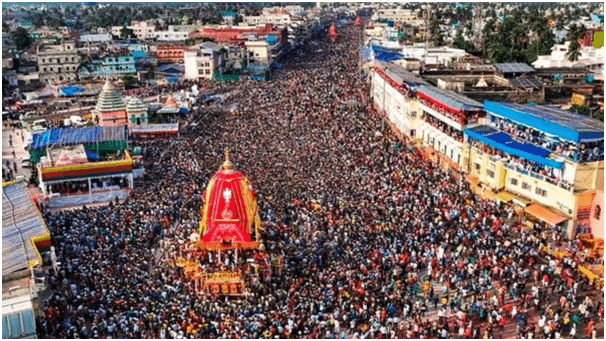Puri Rath Yatra
Context: Millions of visitors from across the globe throng the beach town of Puri in Odisha to take part in the annual Rath Yatra (car festival) of Lord Jagannath, which this year began on June 20.
- According to Hindu mythology, the Lord along with his siblings — elder brother Lord Balabhadra and sister Devi Subhadra — embarks on a nine-day annual sojourn to his birthplace.
- The idols are taken to the Gundicha Temple, where they stay till the ‘Bahuda Yatra’ (returning car festival), scheduled on June 28 this time.
Significance of the Rath Yatra
- The Rath Yatra takes place on the second day of the Odia month of Ashadha Shukla Tithi (bright fortnight) every year to commemorate the journey of Lord Jagannath and his two siblings from their abode —the 12th century Jagannath Temple, to the Gundicha Temple, believed to be their aunt’s home. Goddess Ardhasini, also known as Mausima, is believed to be the deities’ aunt.
- The deities board three huge decorated chariots following the Pahandi ritual (ceremonial procession), before marching for around 3 km to the Gundicha Temple. Millions of devotees pull the chariots on the Bada Danda (Grand Road) of Puri town.
- It is also believed that as non-Hindus are not allowed to enter the Jagannath temple, Lord Jagannath, believed to be the Lord of the Universe, steps out of his sanctum sanctorum during Rath Yatra to meet all his devotees.
About the three chariots
- The three chariots — Taladhwaja Rath for Lord Balabhadra, the Darpadalan Rath for Goddess Subhadra, and the Nandighosa Rath for Lord Jagannath, have their own colours, height, diameter, wooden horses, guardian deities and even charioteers.
- They are made from the wood of locally available trees. Over 150 carpenters, labourers, woodcarvers, artists, and painters work for around 12 hours a day from Akshaya Tritiya onwards, nearly two months before the much-awaited event, to shape the chariots.
- These workers call working on the chariots “hereditary service”. They don’t have any formal training in woodcarving or using modern machinery or equipment but rely on what they have learnt from family elders. Traditional methods and techniques are used to build the chariots.
Chhera Panhara ritual
- Before the chariots are pulled on Rath Yatra, the scion of the erstwhile Puri royal family, who call themselves the first servitor of the Lords, performs a special ritual called “Chhera Panhara”, as part of which he sweeps the floor of the chariots with a golden broom.
- The king arrives in a palanquin from his palace, located around 500 metres away from the temple, in a ceremonial procession and conducts the ritual. The ritual is said to stress the dignity of labour and show that no task is low or high in the eyes of the Lord.
- Puri king Gajapati Dibyasingha Deb, who ascended the throne in 1970 at the age of only 17, has been performing the Chhera Panhara ritual since 1971.
| Practice Question
1. What is the significance of Puri Rath Yatra in the culture of India ? |




